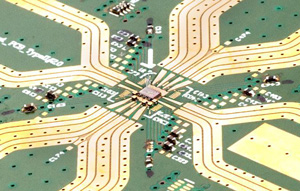SAN FRANCISCO (ISSCC 2015, International Solid State Circuits Conference) – Feb. 25, 2015 — Today, at the 2015 International Solid State Circuits Conference (ISSCC), imec and Panasonic presented a transceiver chip for phase-modulated continuous-wave radar at 79GHz. This achievement demonstrates the potential of downscaled CMOS for cheap millimeter-wave (mm-wave) radar systems that can be used for accurate presence and motion detection.
Mm-wave radar technology is used in advanced driver assistance systems (ADAS) to improve safety in blurry conditions such as dust, fog and darkness, where image-based driver assistance systems lack robustness. It also offers longer range, higher precision and invisible mounting capabilities compared to ultrasound sensors. Imec’s 79GHz radar solution is based on advanced (28nm) CMOS technology, and it is an attractive alternative to the current SiGe-based technology as it offers a path to a low-power, compact and integrated solution. Moreover, at the expected high manufacturing volumes, CMOS technology is intrinsically low-cost.
Imec’s and Panasonic’s transceiver chip contains a control loop to suppress the spillover from the transmitter into the receiver without affecting the RF performance. With a power consumption of 260mW, the output power of the transmitter is 11dBm, while the RX gain is 35dB with a noise figure below 7dB and a TX-to-RX spillover suppression of 15dB. Thanks to the wide modulation bandwidth, the achievable depth resolution is 7.5cm.
“We are pleased with these excellent performance results on 28nm CMOS technology, and excited about the new opportunities they present for mm-wave radar systems, not only for automotive radar, but also for other applications such as smart homes, unmanned aerial vehicles (UAVs), robotics and others.” stated Wim Van Thillo, program director Perceptive Systems for the Internet of Things at imec. “This transceiver chip is an important milestone we have realized in our pursuit of a complete high-performance radar system fully integrated onto a single chip”.
Interested companies have access to imec’s CMOS-based 79GHz radar technology by joining imec’s industrial affiliation program or through IP licensing.

Caption: 28nm CMOS 79GHz Transceiver Chip for Phase-Modulated Continuous-Wave Radar.
Click on the picture to download the high-res version.
About Panasonic
Panasonic Corporation is a worldwide leader in the development and engineering of electronic technologies and solutions for customers in residential, non-residential, mobility and personal applications. Since its founding in 1918, the company has expanded globally and now operates around 500 consolidated companies worldwide, recording consolidated net sales of 7.74 trillion yen for the year ended March 31, 2014. Committed to pursuing new value through innovation across divisional lines, the company strives to create a better life and a better world for its customers.
For more information about Panasonic, please visit the company's website at http://panasonic.net/.
About imec
Imec performs world-leading research in nanoelectronics and photovoltaics. Imec leverages its scientific knowledge with the innovative power of its global partnerships in ICT, healthcare and energy. Imec delivers industry-relevant technology solutions. In a unique high-tech environment, its international top talent is committed to providing the building blocks for a better life in a sustainable society. Imec is headquartered in Leuven, Belgium, and has offices in the Netherlands, Taiwan, US, China, India and Japan. Its staff of over 2,080 people includes more than 670 industrial residents and guest researchers. In 2013, imec's revenue (P&L) totaled 332 million euro. Further information on imec can be found at www.imec.be. Stay up to date about what’s happening at imec with the monthly imec magazine, available for tablets and smartphones (as an app for iOS and Android), or via the website www.imec.be/imecmagazine
Imec is a registered trademark for the activities of IMEC International (a legal entity set up under Belgian law as a "stichting van openbaar nut”), imec Belgium (IMEC vzw supported by the Flemish Government), imec the Netherlands (Stichting IMEC Nederland, part of Holst Centre which is supported by the Dutch Government), imec Taiwan (IMEC Taiwan Co.)and imec China (IMEC Microelectronics (Shanghai) Co. Ltd.) and imec India (Imec India Private Limited).
Source